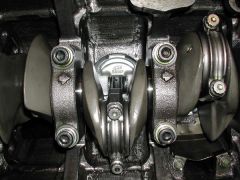-
Posts
9842 -
Joined
-
Last visited
-
Days Won
56
Content Type
Profiles
Forums
Blogs
Events
Gallery
Downloads
Store
Everything posted by johnc
-
That's an unrealistic expectation for composite body parts. Any part from any vendor will require some fitting to our 30+ year old cars. The 240Z carbon fiber and fiberglass hoods I sell can have the inner frame bonded to the hood, but the customer (or the customer's fabricator) will need to make the hinge plates, drill the hood frame, and bolt the brackets to the hood. There's no such thing as bolt on in the automotive aftermarket world and anyone who tells you otherwise is a salesman.
-

building a dream or wasting your cash?
johnc replied to grumpyvette's topic in Gen I & II Chevy V8 Tech Board
A different take on "dreams." The 18 year kid who buys a Ferrari Enzo has reached the pinnacle of automotive nirvana. What automotive thing does he lust for during the next 60 years? Probably nothing. He'll tell his friends "Cars bore me." -
Your shop teacher should stick to teaching kids how to do oil changes on Camrys. Below is a lightened and knife edged L6 diesel crank that had at least 20 hours of hard racing on it at NA power levels over 320 horsepower.
-
What's funny is, after I replaced the welded diff with a Quaife in my 240Z, I broke two stub axles within a month. One at an autocross (annoying but not scary) and one coming off Magic Mountain at Buttonwillow going aobut 80 mph (annoying and really scary). The only thing that saved me was the brake drum and shoes held the stub axle somewhat in place until I could limp back to the pits.
-
A shock will reduce the rate of pitch change, but ultimately the weight is going to the back and the front is going to climb. If you're lucky you will be on the straight by then so its not an issue. BJ is right. Think of it this way... For sake of discussion, let's say that because of wheelbase and CG height the car will transfer 500 lbs. of load to the rear under .8G of acceleration regardless of what springs are on the front and back. That 500 lbs. comes off the front wheels. EXAMPLE 1 (Front 250 lb. in. rate springs with a 1:1 motion ratio in the suspension) Under load the front of the car will extend (pitch up) 1" under acceleration. EXAMPLE 2 (Front 350 lb. in. rate springs with a 1:1 motion ratio in the suspension) Under load the front of the car will extend (pitch up) .71" under acceleration. The front will pitch up the numbers listed above even if you install steel rods in the rear suspension replacing the rear springs. That 500 lbs. of load is moving to the rear and coming off the front of the car. From Mark Ortiz's latest chassis engineering newsletter:
-
Dang! I guess the low 1:32.xxxs I ran at WSIR back when the ROD was a BSP car don't count. And those BSP regional and divisional class wins don't count either. I'll send the trophies back. A car with a welded diff can be made to turn but you have to increase rear stiffness, run little to no rear toe, and a lot of front toe out. Basically you make the car loose and use the throttle to drive. Its actually a lot of fun and can be a fast way around a race track. But, as implied above, it isn't THE fastest way.
-
Its a hypothetical quiz.
-
Let's say the front of your car lifts under acceleration (pitches up) and you want to reduce that behavior because its unloading your splitter and increasing understeer as you exit the corner. Would increasing the front spring rate reduce the pitch, and if so, why?
-

strut tower bar question......
johnc replied to FJ 280z's topic in Brakes, Wheels, Suspension and Chassis
That would be correct if that's how the strut towers flex. But they don't move that way under load. The tops of the towers "twist" inward and towards the rear of the car under cornering loads. Adding a lateral STB reduces the inward movement and running STBs to the firewall reduces the rearward movement. The trapezoid analogy is correct if we are talking about 2D objects. -

Need Help/ Coilovers Question
johnc replied to MY77Z's topic in Brakes, Wheels, Suspension and Chassis
There's a ton of information on this site about coil overs. Take some time, search, and do a lot of reading. -

Question: Have you Seen many "Historic" Datsun cars for sale?
johnc replied to 240ZR's topic in Non Tech Board
$225,000.00 Per IMSA GTU rules at the time the car needed to be updated to look something like a 1976 model so that's why the tailights were swapped. -
They built a simple FEA model of the car from the transmission mount forward including the suspension links. The model was used to develop the transmission mounting, STBs, radiator mount/front ARB reinforcement, and the brake MC bracket. Per the model (if I remember correctly) the loads on the center firewall STB mount are shared between the two bars and 20% of the loads are shear loads across the face of the firewall and 35% are tension loads from one STB pulling against the other. Less then half the load is compression.
-
You'll get more noise and no horsepower.
-

Question: Have you Seen many "Historic" Datsun cars for sale?
johnc replied to 240ZR's topic in Non Tech Board
Here ya go: http://www.canepa.com/inventory/racecar/2790Nissan.html http://www.canepa.com/inventory/racecar/240z.html -
I'm usually working on Saturdays. This Saturday I will be here from 8am to 10am and then off to do some work at a friends shop. Next weekend I'm out at Cal Speeday at the autocross and later the Redline Time Attack.
-
BTW... you might want to come down to my shop. I have a customer's Vintage racing 240Z in here that has an Autopower wheel well mounted roll bar that's been modified to be a roll cage. Its not the best design in the world but VARA and HSR West have allowed the car to run. It also ran with SCCA decades ago but was made illegal in the early 1990s. I'm adding an additional door bar and a knee bar to the cage. http://www.betamotorsports.com
-
Sleeving a tube introduces a stress riser at the weld. Loads imparted into a tube will concentrate at the stress riser and the unsleeved part of the tube will fail where it meets the sleeved part. You're correct in stating the sleeved part of the tube is stronger then the rest of the tube, but that doesn't mean the entire tube is stronger then before. The loads are not spread through the part in a uniform manner. They get concentrated at a point and that concentration will most likely cause the tube to fail at less of a load then if the stress riser didn't exist. The fundamental reason a roll cage works on a unibody car is because it transfers load throughout the structure. Loads input into the unibody or a cage member get transferred to other cage members and other points in the unibody. No one point receives all the load. Race sanctioning bodies specify one continuous tube for the roll cage main hoop to eliminate stress risers that can cause the main hoop to fail. The main hoop is the primary load transfer member in a roll cage and if it fails, loads concentrate at the point of impact. Most other bracing members in a roll cage transfer their loads into the main hoop. An on track accident is rarely just one impact. A poorly built cage can protect the driver from one hit but it will most likely fail in the process. A subsequent hit will leave the driver unprotected at best and, at worse, the failed cage is now debris or sharp projections inside the car increasing the driver's injuries.
-
Everything you ever wanted to know about the Batmobile: http://www.1966batmobile.com
-
You're starting off here right by researching first - also read the rules. Good luck in the sand and bring your can of Silly String.
-
They be Tabco. The dog legs are pretty good.
-
Yes I did. Good luck. I wasn't offended at all. You seem to have a chip on your shoulder and are upset because I didn't post a lengthy response to your question. Sorry. You're ultimate solution is the correct one and I'm glad it worked out. Your original options were really stupid ideas and I, as a SCCA tech inspector, SCCA and NASA driving instructor, and fabricator wouldn't ride in your car on a track if I saw those mods to the roll cage. They are unsafe and were outlawed decades ago by SCCA, NASA, NASCAR, NHRA, etc. None of the race sanctioning bodies (except VARA and HSR West, and only then if its got papers) that I know of and have built roll cages for would allow the modified roll cage you planned on doing with your two options. That should tell you something significant about the safety concerns. That you found some sanctioning body somewhere that might have let you run with the cobbled together mess you were planning to do does not make things safe. There you go - you've got your more lengthy response. Luckily Autopower stepped up and provided you with a main hoop more suitable for your needs. FYI... the roll cage rules put out and enforced by race sanctioning bodies are not there to make things difficult for the competitors. The rules exist to make things safe for the competitors and there are decades of high speed crashes that prove the safety of the designs.

